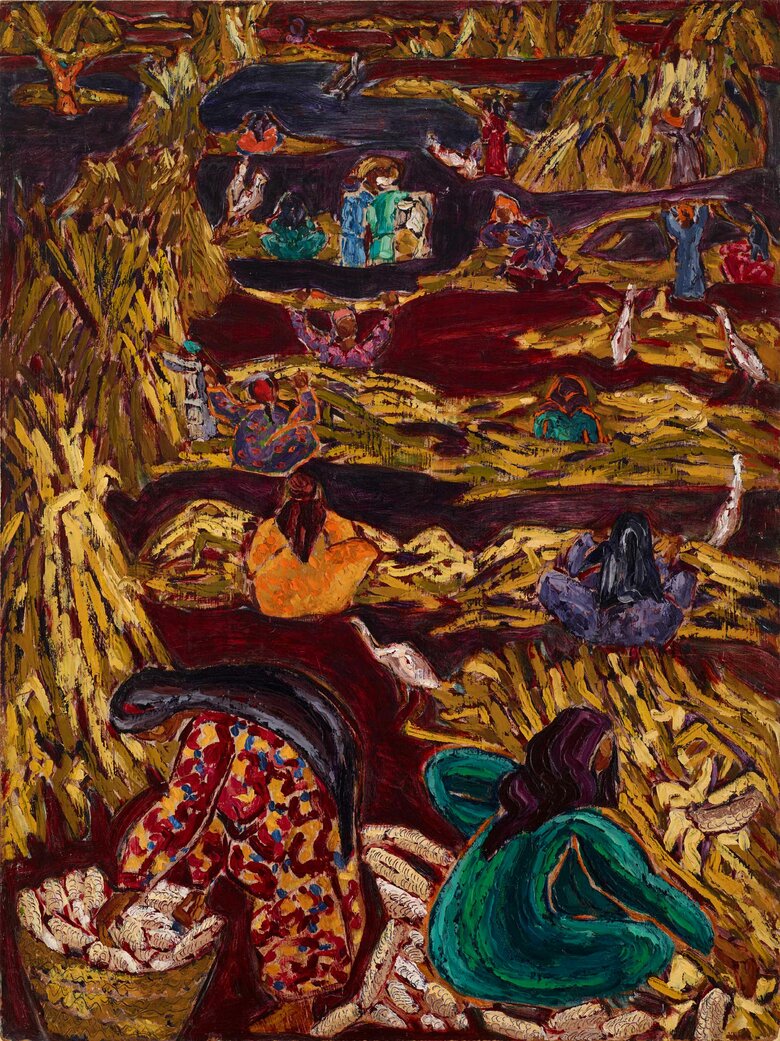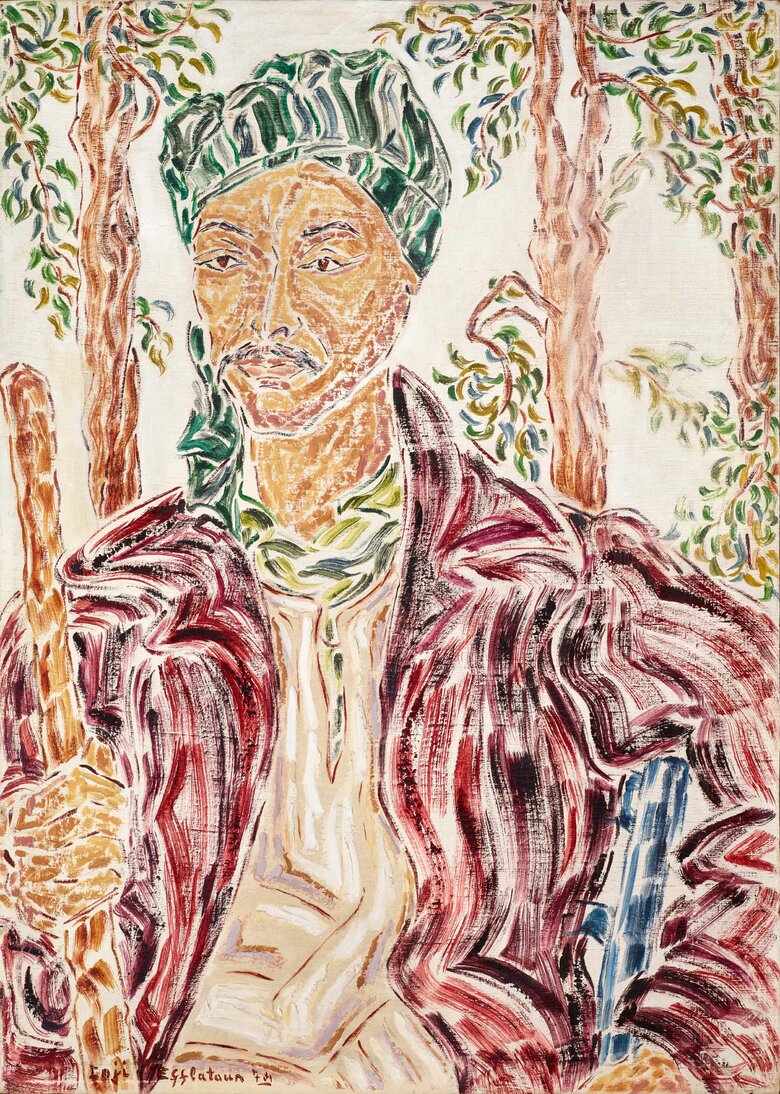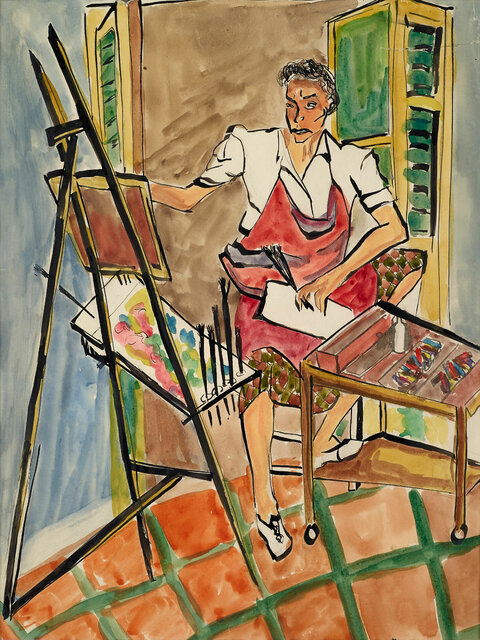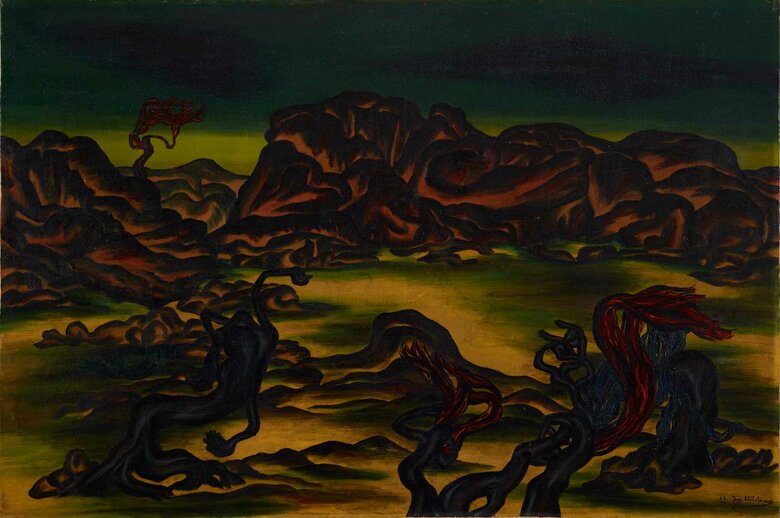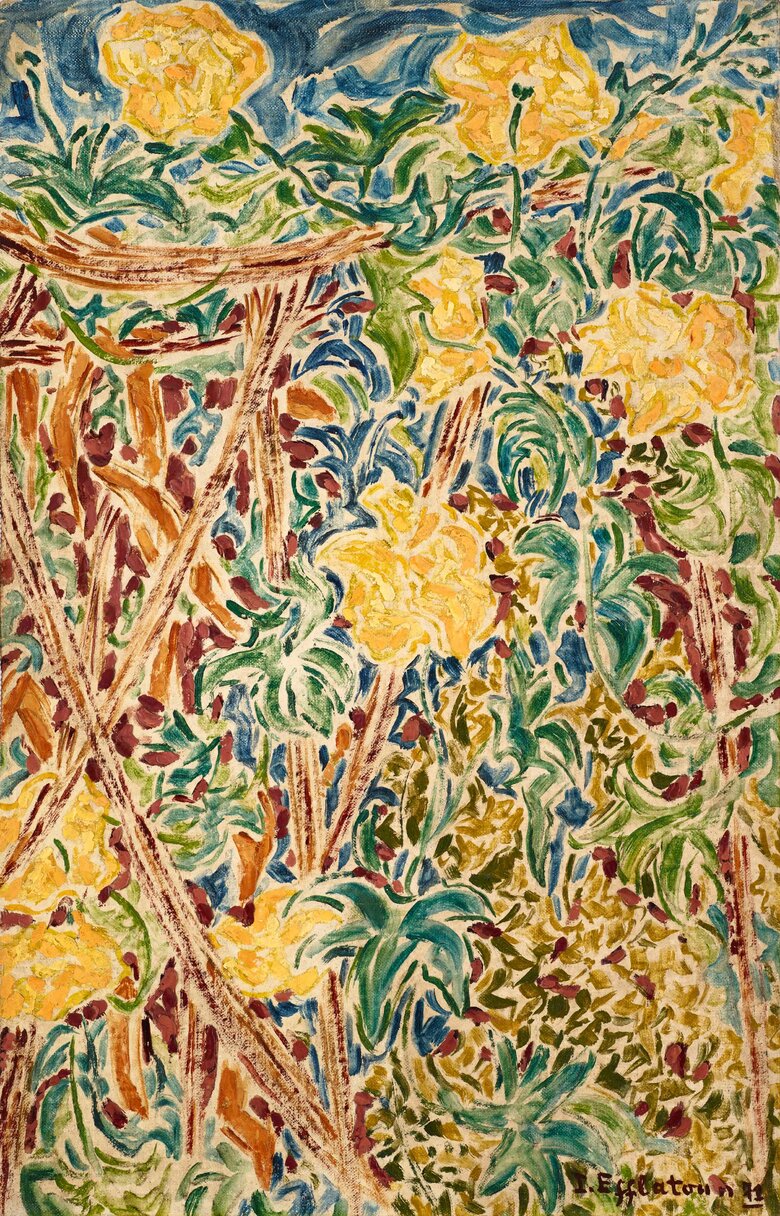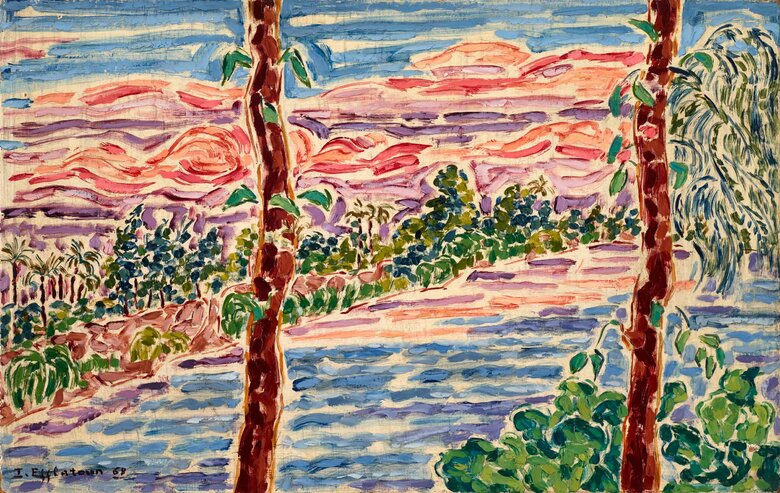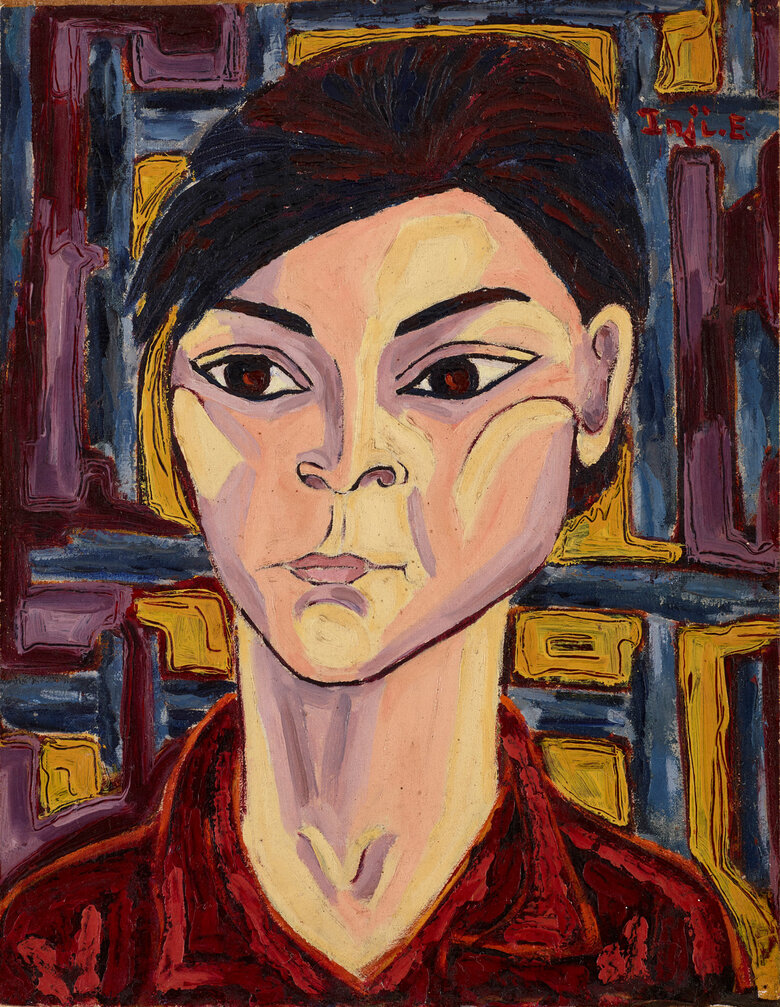Born in 1924 in Shubra district in Cairo to a wealthy and francophone family of landowners, Inji Efflatoun received a Christian and French quality education. First, she went to the Collège du Sacré...
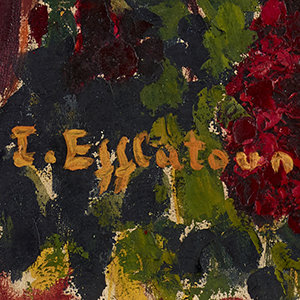

INJI EFFLATOUN, Egypt (1924 - 1989)
Bio
Written by ARTHUR DEBSI
Born in 1924 in Shubra district in Cairo to a wealthy and francophone family of landowners, Inji Efflatoun received a Christian and French quality education. First, she went to the Collège du Sacré Coeur before integrating into the Lycée Français both in Cairo. There, she studied literature, philosophy and expressed particular interest in Marxism theory to the extent that she joined a communist organization called Iskra (al-Sharara) in 1942. When Efflatoun was young, her mother showed her drawings to the Egyptian painter Mahmoud Said (1897-1964), who encouraged to get the girl a tutor. She consequently started taking courses under the supervision of Kamel El Telmissany (1917-1972) at the age of 15. In 1945, she was the first woman enrolled at the Faculty of Arts at Cairo University. In parallel, Inji was a political activist dedicated to different causes, such as feminism. In essence, she co-founded, in 1945, with the novelist Latifa Al-Zayyat (1923-1996), the League of University and Institutes’ Young Women, a leftist organization against British occupation and for Egyptian women rights. Therefore, Efflatoun traveled to Paris to attend the First Women International Congress and represent Egypt’s Women’s Democratic International Federation. She is also known for some publications, namely Eighty Million Women with Us (1948), We, The Egyptian Women (1950), and Peace and Evacuation (1951), addressing political and sociological problems in modern Egypt. Inji Efflatoun kept an intensive exposure to the Egyptian political scene and its severe criticism, she stopped painting from 1946 to 1948 and got married to a leftist lawyer Mohammed Abdul Elija (1923-1957). In the late 1940s, she continued her formation under teachers like the Swiss painter Margo Veillon (1907-2003), Ragheb Ayad (1892-1982), and Hamed Abdalla (1917-1985).
In March 1959, Inji Efflatoun got arrested during a roundup of Communist intellectuals and sent to jail in June. While in detention, she kept on producing her art with the help of her sister Gulperie (Boulie), who provided her with supplies and smuggled the paintings out. The artist was released in July 1963.
The work of Inji Efflatoun is the reflection of her strong personality, as a free and rebel woman. When she trained under el-Telmissany, she detached herself from the academic rules of painting and took more liberties in her practice. Simultaneously, she was introduced to the Egyptian surrealist movement Art et Liberté (Art and Freedom) and contributed to its elaboration. The impact of the group manifested in her early works: she depicted a torturous and imaginary world like Al-Wahesh (The Monster) painted in 1942. These works immerse the spectators in intriguing scenes with dark tones of colors and even sometimes in black and white, specifically in her paper creations. She combined in a surrealist manner several elements like frightening characters with enchanted creatures to create gloomy atmospheres. From that time, the tree became a recurrent motif where Efflatoun registered its similarities with the human being. She imagined that the tree also suffers and could symbolize the human dream spirits. The comparison is such that she gave the trees a human-like appearance as if the branches were arms and the roots were legs, moving in every direction. At that time, Efflatoun conveyed a strong sense of torment in her compositions because she refused to paint superficial themes for the bourgeoisie. Therefore, producing these images was her way to express the unconscious, the irrationality, and to access spiritual liberation.
The next year, her style moved from surrealism to realism, depicting more outdoor scenes like peasant life by the Nile that she notably discovered while traveling to Upper-Egypt and the rural region of Nubia in the mid-1950s. Encouraged by Hamed Abdalla, she decided to illustrate this connection between the farmer and his land as well as the physical efforts of the laborers, which is evident in the paintings The Worker (Hamel al-Tawb) and Construction workers ('Amel al-Bina') both dated from 1950. Applying a thicker paint and warm colors, she showed collective activities insisting on the light effect given by the Egyptian sun. The political message is apparent in these works since Efflatoun aimed to reveal the labor men's life and work conditions, with their misery, dreams, and also their exploitation by the powerful. She also produced some portraits such as Portrait of a Girl (1950) trying to catch the emotions of the individuals that she often drew with a static position and deep gaze. Facing the lives of underprivileged people, the painter became aware of social injustices, the result of Western imperialism. This awareness strengthened her attachment to her country and culture: “Now I began to understand my roots, to be Egyptianized, which was important for my future. In addition, it also meant to speak Arabic rather than French”[1].
Inji Efflatoun's imprisonment was undeniably the defining moment that marked her career and her oeuvre. During this time, she felt the need to paint the harsh reality that she experienced in jail with thieves, dealers, sex workers whom she portrayed as in Portrait of a Prisoner (1963) highlighting the idea of pain and disarray. However, this was too overwhelming for the artist, as she recalled: ‘After some time, I lost the desire to paint the prison and its inmates – the whole place disgusted me’[2].
Later, she stopped portraying the inmates, and came to realize the importance of nature that she was able to see from behind the bars of her cell: for her, the trees and flowers were symbols of freedom. After her incarceration, Efflatoun acquired a mature style characterized by vibrant colors and joyful compositions. The elements of flora are frequent motifs that the artist treated through an idyllic vision of the outside, visible in the following examples Banana Trees (1967) and Flowers (1971). Efflatoun's recurrent subjects remained mostly the countryside's life with people taking care of their daily chores such as in Street of the Village or Washing (Al-Ghassil), both executed in 1968. She optimized the entire space of the canvas and created a dynamic rhythm between the shapes and colors. Her brushstrokes were very delicate and formed a sort of arabesques as they appeared in Akhmeem Roofs (1971), where the drawing lines were so discrete and the pictorial features shaped by the colors.
In Efflatoun’s post-incarceration pieces, the light occupied a central place, it represented liberty and evasion to an artist dazzled by the outside light. This period known as her white light period started in 1974. She could render the light using colors but also and mostly with white (al-daw al-abyad). In later paintings, landscapes, or portraits such as Guard of the Farm (1974), Efflatoun would effectively leave some blank spaces surrounding the different patterns, giving an impression of lightness and inserting movement and air into her canvases.
Coming from the upper-class of the Egyptian society, Inji Efflatoun had this inner feeling to change the previous notions which had persisted for a long time. And through an original artistic style, she manifested her insatiable appetite for freedom.
Inji Efflatoun died in April of 1989 in Cairo.
Notes
[1] Inji Efflatoun quoted in La Duke, Betty. “Egyptian Painter Inji Efflatoun: The Merging of Art, Feminism, and Politics” in NWSA Journal 1, n°3, 1989. [P. 478]
[2] Translated from Arabic by Sarah Dorman in Lenssen, Anneka, A. Rogers, Sarah, and Shabout, Nada. Modern Art in the Arab World, Primary Documents. New York, USA: The Museum of Modern Art, 2018. [P.195]. From the memoirs of Inji Aflatun (excerpt); repr. in Sa’id Khayyal, Mudharkkirat Inji Aflatun, Kuwait: Dar Su’ad al-Sabah, 1993. [PP. 236-244]
Sources
Bardaouil, Sam, and Fellrath, Till. Art Et Liberté, Rupture, Guerre Et Surréalisme En Égypte (1938-1948),[Exhibition Catalogue, ‘Art Et Liberté, Rupture, Guerre Et Surréalisme En Égypte (1938-1948)’. Paris, Centre Georges Pompidou, October 19th 2016 – January 16th 2017]. Paris, France: Skira, 2016.
Eigner, Saeb. Art of the Middle-East, Modern and Contemporary Art of the Arab World and Iran. London, UK: Merell Publishers Limited, 2011.
Karnouk, Liliane. Modern Egyptian Art, 1920-2003. Cairo, New York, Egypt, USA: The American University in Cairo Press, 2005.
La Duke, Betty. “Egyptian Painter Inji Efflatoun: The Merging of Art, Feminism, and Politics” in NWSA Journal 1, n°3, 1989.
Lenssen, Anneka, A. Rogers, Sarah, and Shabout, Nada. Modern Art in the Arab World, Primary Documents. New York, USA: The Museum of Modern Art, 2018.
Lenssen, Anneka. “Inji Efflatoun: White Light.” in Afterall: A Journal of Art, Context and Enquiry 42 (2016): 84–95. https://doi.org/10.1086/689806.
Sharobeem, Heba. “When the Personal Becomes Collective: A Study of an Activist’s Memoir.” Accessed April 17, 2020. http://www.ll.ac.me/ll 3(2)/Heba 113-130.pdf.
https://www.youtube.com/watch?v=ulTAQaffIBU (viewed April, 17th 2020)
CV
Selected Solo Exhibitions
2019
Mémoires of Inji, Safarkhan Gallery, Cairo, Egypt
2016
Freedom After Prison, Safarkhan Gallery, Cairo, Egypt
2015
Mother Tongue: Selected Works by Inji Efflatoun, Mathaf: Arab Museum of Modern Art, Doha, Qatar
2014
Inji’s World, Safarkhan Gallery, Cairo, Egypt
2013
A Life in Struggle, Safarkhan Gallery, Cairo, Egypt
2012
Picasso Art Gallery, Cairo, Egypt
2004
Safarkhan Gallery, Cairo
2002
A Selection of Museum Holdings for the Artist Inji Efflatoun (1924-1989), Mahmoud Mohamed Khalil Museum, Cairo, Egypt
1999
10th Year Anniversary of Inji Efflatoun’s death, Cairo Library, Center for New Women’s Studies, Cairo, Egypt
1994
Zamalek Arts Centre, Cairo, Egypt
1990
Nile Hall, Cairo, Egypt
1989
Atelier du Caire, Cairo, Egypt
1988
Kuwait
1987
Zamalek Arts Centre, Akhenaton Gallery, Cairo, Egypt
1985
Inji Efflatoun (1942-1985), Zamalek Arts Centre, Akhenaton Gallery, Cairo, Egypt
1981
Egyptian Art Academy, Rome, Italy
1979
New Delhi, India
1977
Inji Efflatoun: White Light: 1974-1977, The Egyptian Center for International Cultural Cooperation, Cairo, Egypt
1975
The State Museum of Oriental Art, Moscow, Russia
1974
Touring Exhibition, Moscow, Russia; Prague, Czech Republic; Sofia, Bulgaria
1973
Egyptian Center for International Cultural Cooperation, Cairo, Egypt
1971
Atelier du Caire, Cairo, Egypt
1970
Galerie, Inji Efflatoun: Vereinigte Arabische Republik; Malerei, Berlin, Germany
The State Museum of Oriental Art, Moscow, Russia
1969
Atelier du Caire, Cairo, Egypt
1967
Paese Nove Gallery, Rome, Italy
Galerie de l’Université, Paris, France
1964
Akhenaton Gallery, Cairo, Egypt
1959
Atelier du Caire, Cairo, Egypt
1956
L’Atelier du Caire, Egypt
1954
Le Gallion, Cairo, Egypt
1953
Gallery Aladin, Cairo, Egypt
Association des amitiés Française, Alexandria, Egypt
1952
Gallery Adam, Cairo, Egypt
Selected Group Exhibitions
2025
Radical: Women Artists and Modernism 1910-1950, Museum Arnhem, Arnhem, Netherlands
Visions in Aquarelle, Safar Khan Gallery, Cairo, Egypt
Women's Agency in Arab Art: Kinship, Education, and Political Activism, Lebanese American University, Beirut, Lebanon
2024
Sunburst: Safarkhan Anthology 2024, Safar Khan Gallery, Cairo, Egypt
Arab Presences: Modern Art And Decolonisation: Paris 1908-1988, Musée d'Art Moderne de Paris, Paris, France
Constellations of Multiple Wishes: Along the Eastern Horizont, +MSUM - Museum of Contemporary Art Metelkova, Ljubljana, Slovenia
Visions in Aquarelle, Safar Khan Gallery, Cairo, Egypt
2023
The YES Collection, Sotheby's Dubai, Dubai, United Arab Emirates
Crossroads: A Collector’s Tale, Picasso Art Gallery, Cairo, Egypt
Modern and Contemporary Art of the Arab World, Christie’s London, St. James's, London, UK
Constellations of Multiple Wishes, The Mosaic Rooms, Kensington, London, UK
UNTITLED Abstractions, Dalloul Art Foundation, Beirut, Lebanon
Parallel Histories, Sharjah Art Museum, Sharjah, United Arab Emirates
2022
The Collector’s Eye IX, Ubuntu Art Gallery, Cairo, Egypt
The Modernists: A Retrospective, Safar Khan Gallery, Cairo, Egypt
Memory Sews Together Events That Hadn’t Previously Met, Sharjah Art Museum, Sharjah, United Arab Emirates
Positions and Points of View | Partis Pris et Points de Vue, Matignon, Paris, France
A Century of the Artist’s Studio: 1920-2020, Whitechapel Gallery, London, UK
Picasso et les avant-gardes arabes, Institut du Monde Arabe,Tourcoing, France
2021
Contemporary African Art from the permanent collection of the Jordan National Gallery of Fine Arts, The Jordan National Gallery of Fine Arts Amman, Jordan
2020
Notre Monde Brûle, Palais de Tokyo, Paris, France
2019
From Mokhtar To Gazbia, Art Talks Egypt, Cairo, Egypt
2018
A Century in Flux, Sharjah Art Museum, Sharjah, UAE
Syria Matters, Museum of Islamic Art, Doha, Qatar
Revolution Generations, Mathaf: Arab Museum of Modern Art, Doha, Qatar
2017
Surrealism in Egypt: Art et Liberté 1938-48, Tate Modern, London, UK; Moderna Museet, Stockholm, Sweden
When Art Becomes Liberty: The Egyptian Surrealists (1938-1965), National Museum of Modern and Contemporary Art, Seoul, South Korea
Modern Art from the Middle East, Yale University Art Gallery, New Haven, US
Modernist Women of Egypt, Green Art Gallery, Dubai, UAE
2016
Art et Liberté: Rupture, War and Surrealism in Egypt (1938–1948), Centre Pompidou, Paris, France; Museo Nacional Centro de Arte Reina Sofía, Madrid, Spain; K20, Kunstsammlung Nordrhein-Westfalen Düsseldorf, Germany
When Art Becomes Liberty: The Egyptian Surrealists (1938-1965), Palace of Arts, Cairo, Egypt
The Short Century, Sharjah Museum, Sharjah, UAE
Summer Collection, Safarkhan Art Gallery, Cairo, Egypt
2015
56th International Art Exhibition, All The Worlds Futures, Venice Biennale, Venice, Italy
Barjeel Art Foundation Collection – Imperfect Chronology: Debating Modernism I, Whitechapel Gallery, London, UK
From the Nile to the Two Holy Sites (February), 8th Jeddah Art Fair, Jeddah, Saudi Arabia
2014
Sky Over The East, Emirates Palace, UAE
Arab Anthology Exhibition, 7th Jeddah Art Fair, Jeddah, Saudi Arabia
2013
Salon du Caire, Cairo, Egypt
2010
Prince Amr Ibrahim Palace (Museum of Islamic Ceramics), Cairo, Egypt
12th Picasso Art Gallery Summer Exhibition, Picasso Art Gallery, Cairo, Egypt
2009
Creative Egyptian Female Artists Exhibition, Berlin, Germany/ Vienna, Austria
1994
The National Museum of Women in the Arts, Washington D.C., USA
1992
Egyptian Academy of Art, Rome, Itlay
1991
Atelier du Caire, Cairo, Egypt
1990
Women Artists in Cairo (on the occasion of International Women's Day), American University of Cairo, Cairo, Egypt
1988
Sao Paolo Biennale, Brazil
Alabama, US
1976
87ème Salon des Artistes Indépendants, Grand Palais, Paris, France
1975
Ten Egyptian Women Paint over Half a Century, Cairo, Egypt
1974
Contemporary Egyptian Art, Belgrade, Serbia
1971
Contemporary Egyptian Art, Paris, France
1968
Biennial of Venice, Venice, Italy
1958
Alexandria Biennial, Egypt
1953
Sao Paolo Biennial, Brazil
1943
Exhibition of the Art and Liberty Group, Cairo, Egypt
1942
Troisième Exposition de l’Art Indépendant, Hôtel Continental, Downtown Cairo, Cairo, Egypt
Curatorial projects
1975
Ten Egyptian Women Artists, the Arab Socialist Union in Cairo gallery, Cairo, Egypt
1971
Visages de l’art contemporain égyptien, the Musée Galliera, Paris, France.
Awards and Honors
1988
Cavalier of the Arts and Literature, Ministry of Culture, Cairo, Egypt
1955
"Chevalier dans l'Ordre des Arts et des Lettres" The Award of Knight of the
Order of Arts and Letters, French Ministry of Culture, Paris, France
1959
The Top Prize, Landscape Competition, during an exhibition organized by the Ministry of Culture
1956
Two Prizes from Cairo Salon, Egypt
Publications
2014
Muzakarat Inji Efflatoun: Min Al-Toufoula ila Al-Sign (Inji Efflatoun's Memoirs: From Childhood to Prison) by Inji Efflatoun, published by Dar Al-Thaqafa Al-Jadida, Cairo, Egypt
1993
Sac īd Khayāl (ed.). Mudhakkirāt Injī Aflātūn (The Memoirs of Inji Efflatoun). Kuwait: Dar Sucād al-Sabāh,
1949
Nahnu al-nisaa' al-missriyyat (We Egyptian Women), political pamphlet published by Inji Efflatoun, Cairo, Egypt
1948
80 milyoun imra'a ma'anā (80 Million Women with Us), political pamphlet published by Inji Efflatoun, Cairo, Egypt
Collections
Amir Taz Palace, Cairo, Egypt
Mathaf: Arab museum of modern art, Doha, Qatar
The Ramzi & Saeda Dalloul Art Foundation, Beirut, Lebanon
Barjeel Art Foundation, Sharjah, UAE
Museum of Modern Art, Cairo, Egypt
Museum of Modern Art, Alexandria, Egypt
Museum of Modern Art, Dresden, Germany
National Museum in Warsaw, Warsaw, Poland
Oriental Museum, Sofia, Bulgaria
Pushkin Museum, Sophia, Bulgaria
Pushkin Museum, Moscow, Russia
The Jordan National Gallery of Fine Arts Amman, Jordan
Press
إنجي أفلاطون والفرشاه النسوية المتمردة احكي.pdf
مذكرات إنجي أفلاطون وتأريخ لبداية الحركة النسوية والاشتراكية في مصر Open.pdf
متحف إنجى أفلاطون.. رحلة زهرة الصبار والانحياز للكادحين.pdf
شبكة رؤية الإخبارية إنجي أفلاطون.. الفنانة التي رفضت المجتمع المغلف بالسلوفان.pdf
انجى افلاطون وذكريات «كفر شكر» - الأهرام اليومي.pdf
إنجي أفلاطون.. من الأرستقراطية إلى الاشتراكية.. رحلة القصر والمعتقل - بوابة الشروق.pdf
إنجي أفلاطون.. لا يكفي أن يكون الفن مع الفقراء.pdf
إنجي أفلاطون_ من القصر إلى صفوف الكادحين.pdf
إنجي أفلاطون_ فنانة مصرية سجنها عبد الناصر واحتفى بها غوغل - BBC News عربي.pdf
إنجي أفلاطون فنانة وكاتبة سياسية صبغت نساء مصر بألوانها.pdf
إنجي أفلاطون أرستقراطية عاشت للحرية - الأهرام اليومي.pdf
أعمال إنجي أفلاطون.. ذاكرة نضال نسوي عبر الرسم ناهد خزام صحيفة العرب.pdf
Women, art and the nation. History of t...and Gazbia Sirry — AWARE Women Artists.pdf
WideWalls.pdf
The upperclass girl who became a socialist and pioneer of Egyptian art - Your Middle East.pdf
Who was Inji Aflatoun Google Doodle honours Egyptian painter and feminist - The National.pdf
The upperclass girl who became a socialist and pioneer of Egyptian art - Your Middle East.pdf
The Activism of Arab Women Artists - CCAS.pdf
Print.pdf
Overlooked No More_ Inji Efflatoun, Egyptian Artist of the People - The New York Times.pdf
Mohamad Al Hamamsi MEO.pdf
Inji Efflatoun in Prison (1959–1963)_ Painting the Unrenewable - post.pdf
Inji Efflatoun (1924-1989)_ A Life in Struggle artBahrain.org.pdf
Inji Efflatoun - Archives of Women Artists, Research and Exhibitions.pdf
Gulf-Times.pdf
Google Doodle Celebrates Egyptian Painter Inji Aflatoun_s 95th Birthday Harper_s BAZAAR Arabia.pdf
ArtBahrain.pdf
Appollo-Magazine.pdf
BBC News Arabic Inji Efflatoun 2019.pdf
Ahram Online - Permanent art exhibition...Inji Aflatoun opens at Amir Taz Palace.pdf
Al Ahram Inji Efflatoun 2019.pdf
Ahram.pdf
في ذكرى رحيلها.. محطات في حياة إنجي أفلاطون إحدى رائدات الفن التشكيلي في مصر - بوابة الشروق.pdf
Inside Inji Aflatoun’s Prison Cell.pdf
احتفاء في مصر بمئوية التشكيلية الرائدة إنجي أفلاطون.pdf
منيرة ثابت ضد إنجي أفلاطون_ وقائع معركة منسية دفاعا عن حقوق المرأة - باب مصر.pdf
The permanent revolution_ From Cairo to Paris with the Egyptian surrealists MadaMasr.pdf
INJI EFFLATOUN Artwork
Become a Member
Join us in our endless discovery of modern and contemporary Arab art
Become a Member
Get updates from DAF
Follow Artists
Save your favourite Artworks
Share your perspectives on Artworks
Be part of our community
It's Free!
We value your privacy
TermsCookiesPrivacy Policies
Become a Member
Get updates from DAF
Follow Artists
Save your favourite Artworks
Share your perspectives on Artworks
Be part of our community
It's Free!
We value your privacy
TermsCookiesPrivacy Policies
Become a Member
Get updates from DAF
Follow Artists
Save your favourite Artworks
Share your perspectives on Artworks
Be part of our community
It's Free!
We value your privacy
TermsCookiesPrivacy Policies
Welcome to the Dalloul Art Foundation
Thank you for joining our community
If you have entered your email to become a member of the Dalloul Art Foundation, please click the button below to confirm your email and agree to our Terms, Cookie & Privacy policies.
We value your privacy, see how
Become a Member
Get updates from DAF
Follow Artists
Save your favourite Artworks
Share your perspectives on Artworks
Be part of our community
It's Free!
We value your privacy
TermsCookiesPrivacy Policies

